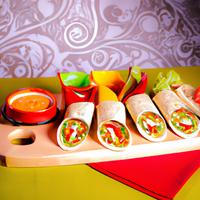
1 serving (200 grams) contains 300 calories, 12.0 grams of protein, 10.0 grams of fat, and 40.0 grams of carbohydrates.

Log this food in SnapCalorie

Nutrition Information
Calories |
352.9 | ||
|---|---|---|---|
% Daily Value* |
|||
| Total Fat | 11.8 g | 15% | |
| Saturated Fat | 3.5 g | 17% | |
| Polyunsaturated Fat | 0 g | ||
| Cholesterol | 35.3 mg | 11% | |
| Sodium | 588.2 mg | 25% | |
| Total Carbohydrates | 47.1 g | 17% | |
| Dietary Fiber | 3.5 g | 12% | |
| Sugars | 4.7 g | ||
| protein | 14.1 g | 28% | |
| Vitamin D | 0 mcg | 0% | |
| Calcium | 94.1 mg | 7% | |
| Iron | 2.4 mg | 13% | |
| Potassium | 294.1 mg | 6% | |
* Percent Daily Values are based on a 2,000 calorie diet. Your daily values may be higher or lower depending on your calorie needs.
Food Attributes
Source of Calories
About Katthi roll
Katthi Roll is a popular street food originating from Indian cuisine, celebrated for its vibrant flavors and convenience. It typically consists of a flaky, golden paratha or roti wrapped around a filling that can include spiced chicken, paneer, vegetables, or eggs. The roll is often garnished with fresh onions, tangy chutneys, and aromatic spices that enhance its taste. Nutritionally, Katthi Rolls can be balanced, offering protein from the filling and fiber from added vegetables. However, they can also be calorie-dense due to the paratha, which is usually cooked with oil or ghee. Opting for whole wheat wraps and leaner filling choices, such as grilled chicken or tofu, can improve its nutritional profile. While Katthi Rolls are not inherently unhealthy, portion control and mindful ingredient selection can transform this indulgent treat into a flavorful and wholesome meal option.



